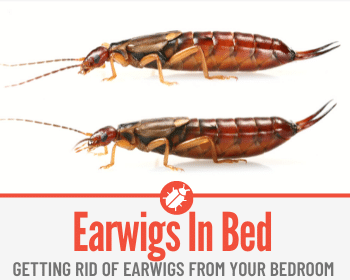 Wondering If Earwigs Can get In your bed? Why would they even want to get in your bed?
Wondering If Earwigs Can get In your bed? Why would they even want to get in your bed?
In this guide you will learn:
- Why Do you have earwigs in your bed,
- Can Earwigs attack and bite you while you sleep,
- How to make sure that it’s the Earwig Biting you and not other pests,
- How to Get rid of Earwigs from your Bed & Prevent them in Future.
Can Earwigs Climb and Get into Bed?
The short answer is yes, earwigs can get into your bed. Earwigs can climb most surfaces, and a bed—particularly with a bedspread or other soft, easily-climbed material—doesn’t pose much of a problem to them.
Some earwigs also have wings, and though they’re not great at using those wings they do still function enough for short flights.
Why Do I have Earwigs in my bed?
Earwigs prefer hanging out in dark spaces (they also love moist spaces, I’ll touch on that in just a moment). Even during the day, the pillows and blankets on your bed provide plenty of cozy, dark places for an earwig to hide out.
The presence of earwigs in your home can indicate water problems.
Check for water damage in areas around your hot water tank, washing machine, dishwasher, and anywhere else you think there might be leaks or issues. You may need some repairs done.
Do Earwigs Bite You in Your Sleep?
If they feel threatened, earwigs will bite humans to defend themselves, whether the human is awake or asleep. On the bright side, earwigs are not venomous and the bites are not serious or dangerous even if they might sting quite a lot!
More good news is that, unlike a mosquito or a bed bug, an earwig doesn’t really want to bite you.
They don’t have a reason to—they don’t consume blood, so you’re not on the menu.
Earwig vs Bed Bug
For most of us, the most important difference between bed bugs and ear wigs is that earwigs don’t want to bite you and bed bugs do. Most earwigs eat dead plants or smaller insects, while bed bugs only feed on blood.
There are other differences as well!
Earwigs are considered semi-social, meaning they don’t always live in groups, and when they do the groups tend to be smaller. Bed bugs are social, meaning they tend to live in larger groups.
Earwigs have more slender bodies, pinchers, and many have wings. They tend to be brown in color. Bed bugs are small, more flat, and almost an oval in shape, with no wings. They tend to be reddish.
They do have a couple of similarities, though.
Both earwigs and bed bugs prefer the dark, but keeping your bedroom lit up all night won’t do anything to scare them away, it’ll only give you a poor night’s sleep.
Both earwigs and bed bugs tend to get into your home by hitching a ride on objects that you’re moving into your house.
Do Earwigs Eat Bed Bugs?
Some can! Most species of earwigs prefer to chow down on dead plant matter, but a few are predators who prey on smaller insects.
How Can Earwigs Get in my Bedroom?
The truth is, if there’s earwigs in your bedroom you’re probably bringing them in yourself.
Earwigs burrow into new hiding places frequently, and this can include anything set down outside that you plan to bring inside.
This is especially true if the item you’re bringing into your home has been outdoors for longer periods of time, particularly overnight.
Earwig Larvae
If I found an earwig in my bed, I know I’d spend the next few weeks checking for larvae (or rather, baby earwigs) in my bed, pillows, sheets, blankets, and probably other parts of my bedroom.
Baby earwigs are called nymphs, and they hatch from small, almost-round eggs. They typically come out tiny and pale, with their pincher not fully formed, but otherwise look pretty much the same as they will as an adult. This means if you spot one, it shouldn’t be too hard to identify.
The good news is that it’s not terribly likely that an earwig will lay eggs in your bed to start with.
It can happen, but your bed isn’t their ideal breeding ground. They prefer dark, moist, and protected spaces to lay their eggs.
A human’s bed, occupied for hours every night, made in the morning, and stripped and laundered regularly, doesn’t seem as appealing for an earwig to lay her eggs as a nice pile of dirt or wet leaves.
How Do I Get Rid of Earwigs on my Bed?
The simplest way to get rid of earwigs from your bed is to vacuum them up, as well as any eggs. Then either throw away the vacuum bag or empty the vacuum’s container into a bucket of slightly soapy water to drown the earwigs.
You can also spray the area with a mixture of dish soap and water, or a mixture of rubbing alcohol and water (the rubbing alcohol mixture can also kill them if sprayed right on them).
There’s also the option of trapping them by mixing olive oil and soy sauce together into a small dish and placing the dish near the bed where you’ve seen them. They like the smell, will come to eat up, and will drown instead.
If you have no pets or small children, or if you have areas in your home that pets and small children can’t access, you could consider applying boric acid powder. Follow all instructions properly when using any product.
A quick internet search will also give you the option of sprays or traps that can be used to eradicate earwigs.
As noted above, when using any product be sure to correctly follow all instructions- especially if you plan to use them around your bed!
Related: Centipedes in your bed
Preventing Earwigs in your Bed and Bedroom in the Future
The best way to Prevent Earwigs in your bed and Bedroom is to make your house as less attractive to earwigs as possible.
Make sure your gutters and spouts are clear and that they drain excess water away from your house. Check your home for water damage, or for spots where there’s the risk of water damage, and make sure to pay attention to upkeep in those areas.
Look for cracks in the foundation of your home and seal them up, and make sure that there are no gaps when your windows and doors close. Check screens for tears and get them repaired or replaced if necessary.
There are pest repellants available online, with a little research you can find well-regarded products.
Follow instructions for use of any such products.






